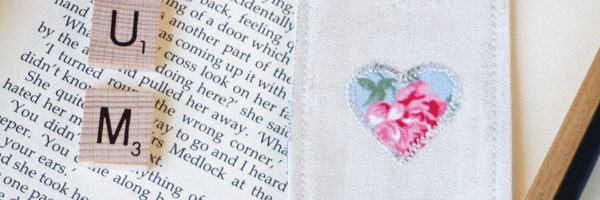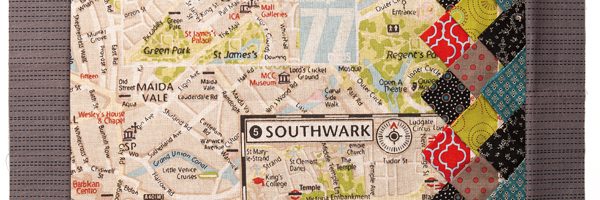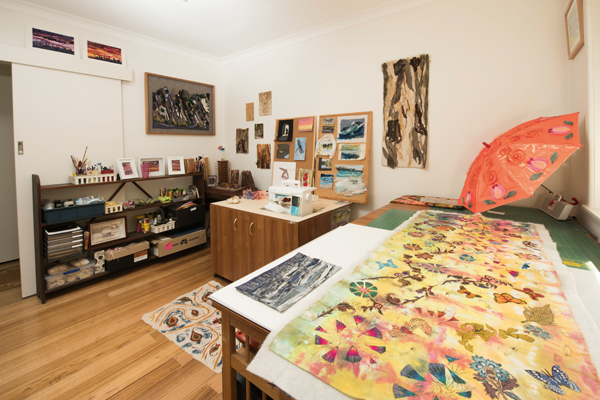
See Inside Mary McArdle’s Studio
We take a peek into Mary McArdle’s studio in Victoria to see how her well-ordered space facilitates the creation of her original textile works.
By Erica Spinks, Photography by Ned Meldrum
Mary’s studio is an east-facing former bedroom that has been renovated specifically for her purposes and receives wonderful morning light. During other times of the day and night, she relies on a daylight lamp in a swivelling stand to supply even light, which is important for detailed work.

Spring At Midnight Quilt is one of our most popular projects!
Her studio has newly painted walls “that have demanded I hang some of my work on them”, Mary says. “One of the things I love about the room is that we have taken the carpet out — it means it is much easier to clean!”
Two wardrobes in her studio contain supplies, although she confesses “there is also a large cupboard just outside the room that is partially for my textile storage”. Mary prefers to use the materials she already has before buying more to add to her stash. “The renovation required lots of sorting and culling, so now I feel I have a better idea of what I have and want to do,” she adds.
As a child, Mary was taught embroidery and knitting skills by her mother and this provided the foundation of her creative life. She later completed an academic minor in art, focussing on hand embroidery, as part of her primary school teaching qualifications. As a teacher, she found that her ongoing personal creative projects spilled over into her classroom practice.
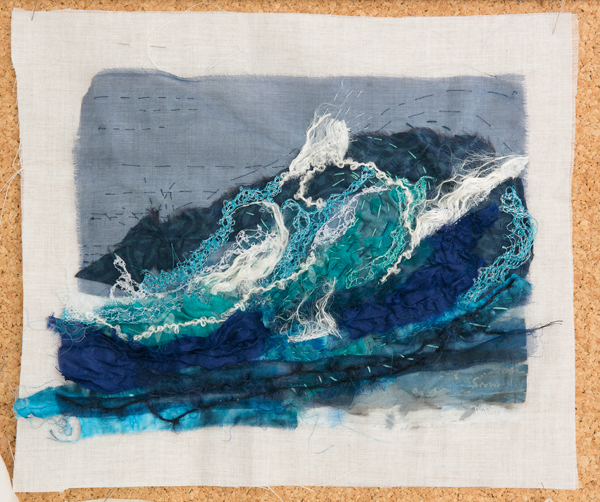
“I used to use the skills, my love of colour, pattern and textiles in my teaching,” she explains. “I often used patchwork patterns as part of my maths teaching. I would take in my current projects and talk about the many possibilities of making a design using simple shapes. Then the class would play around with shapes, two colours and devise different patterns.”
Learn raw-edge machine applique, reverse applique and machine quilting with Amanda Daly
Textiles and colour were also incorporated into the science and art parts of the curriculum. “In some years, I had silk stretched out in the back of the room and the children would have turns painting on silk,” she explains. “The attraction was the mixing of colours, the different effects you could get on silk by using different chemicals such as salt and sugar. For many years I had silkworms in my classroom. We would learn about the lifecycle of the silk moth as well as the attributes of silk.”
While developing her primary school students’ skills, Mary was developing her own expertise by taking classes in quilt making and learning how to effectively use her sewing machine. “There is something very calming about hand work but also with the quicker machine work there is satisfaction in choosing colours, putting together patterns and creating something useful as well as beautiful,” Mary adds.
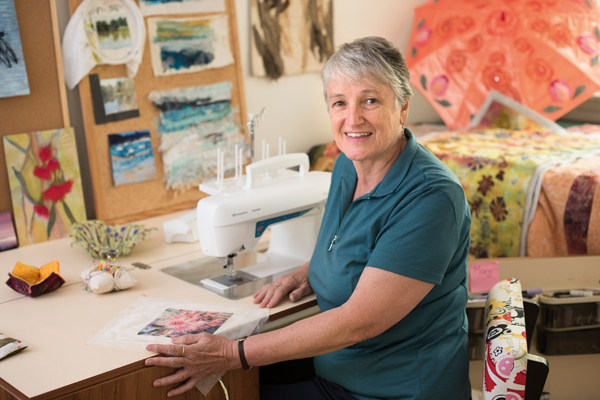
“I love attending workshops, seeing how things are done and learning about the artistic decisions the tutors make. I don’t always follow up on the techniques but I do find that I adapt ideas and incorporate them into later projects. I have dabbled in many different sorts of fibre arts and am currently trying to develop a more focussed practice.”
Mary’s textile work is usually inspired by her local environment, including a huge lemon-scented eucalyptus tree that is visible from her studio. “The tree gives me endless inspiration because it changes colour according to the ambient light. I have also dyed fabric using its leaves and bark,” she says.
Since welcoming a dog into her household 10 years ago, Mary visits local parks often and admires the variety of colours, textures, lines, spots and patterns she finds around her. “I also enjoy walking around the city,” she says. “I see the reflections, lines and patterns there, which are so different from the more organic natural patterns.”
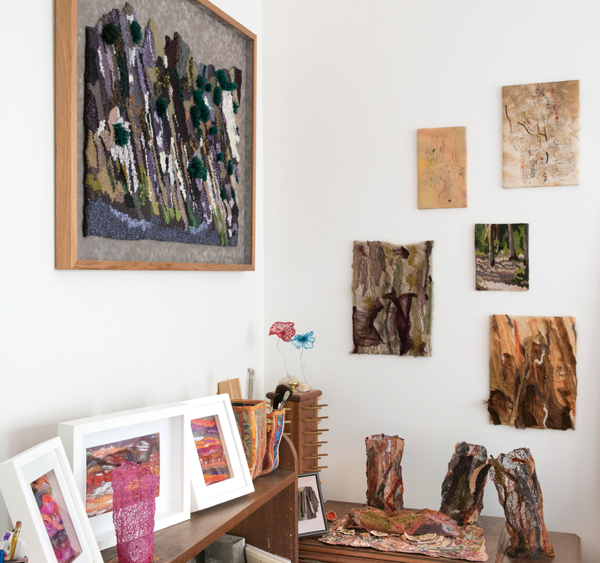
A large part of Mary’s studio is filled by a cutting table and sewing machine arrangement. Although both tables can be folded up when not in use, they are usually left set up. “I am currently working on wall hangings rather than more functional textile work,” she explains. “Since I have organised my stash better I have been able to see what I have and have decided to use it up.
This has led me to doing fabric collage. My current interest is combining the fabric collage with scenes, cityscapes (I have an interesting view across to the city from a nearby street), landscapes and seascapes. I am trying to be more abstract in my designing and I find that collage helps with this.”
Learn how to modernise traditional quilt blocks with Leanne Harvey!
To create her fabric collage, Mary usually uses adhesive webbing to stick down the initial pieces and then machine-sew them, using heavy thread work to blend colours as well as provide the texture she loves. She will often include interesting yarns to add even more texture. She reflects further on the idea of her textile work always being functional: “This idea of making something useful can interfere with the work though, especially when working with textiles. People often ask what I will do with it and I ask myself that too. Sometimes it is not a matter of what it is for, it is just the making that is satisfying.”
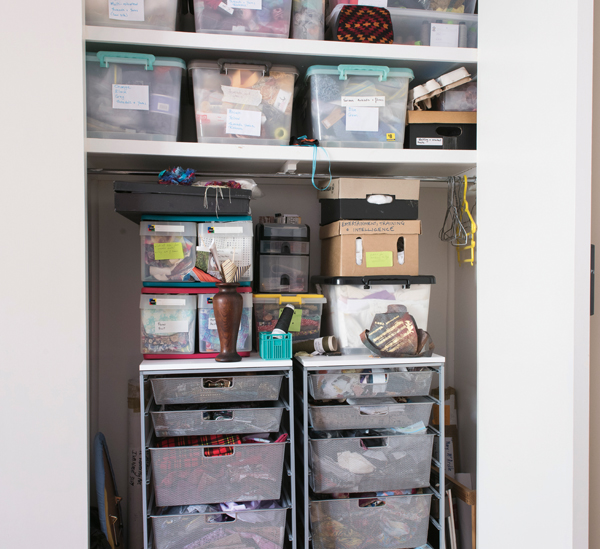
Mary is a member of the Embroiderers Guild, Victoria, the Handweavers and Spinners Guild of Victoria Inc, and the online groups Australian and New Zealand Art Quilters and Tapestryweaversoz. “Being in an online group allows me to learn lots from the other members in a supportive environment,” she says. The challenges organised by both online groups have encouraged Mary to explore different techniques and materials, while often working to specified themes. The current Australian and New Zealand Art Quilters challenge quilts were exhibited at the Australasian Quilt Convention earlier this year, while the tapestry challenge pieces travel to various venues throughout Australia and New Zealand.
Mary is also secretary and newsletter editor for the volunteer-run Alcove Art Shop in Box Hill, which provides an outlet for local artists and artisans to sell their work. The participants hold two exhibitions a year where all the works are for sale. One of Mary’s creative objectives is to develop a body of her textile work to sell through this and other outlets. “I am not at that stage yet and am not sure that I ever will be,” she says. “I just love the thinking, the planning and then the coming together of the works. If I can have someone love them enough to pay money for them, then that’s an extra bonus.”
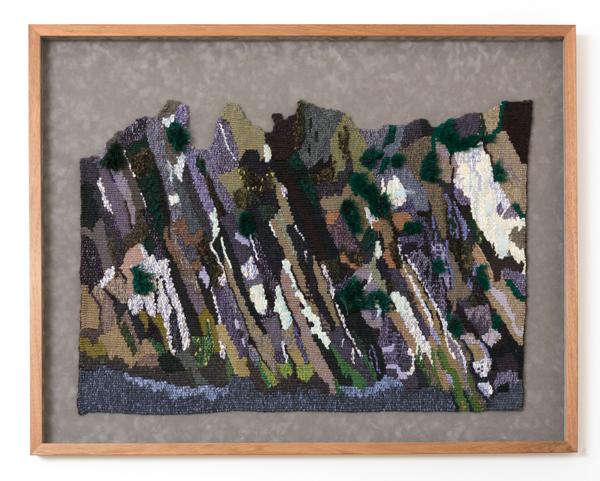
Another creative objective is to enter her work in more exhibitions. “After finishing my Diploma of Studio Textiles and Design, eight students had an exhibition and I have also entered exhibitions organised by the groups I belong to. That has given me the impetus to answer some other calls for entry,” she explains. Mary has participated in the Petite Miniature Textiles exhibition at Wangaratta Art Gallery, the Buda Contemporary Textiles Exhibition, Home: a Banyule exhibition, and the Beneath the Southern Sky and A Matter of Time travelling exhibitions.
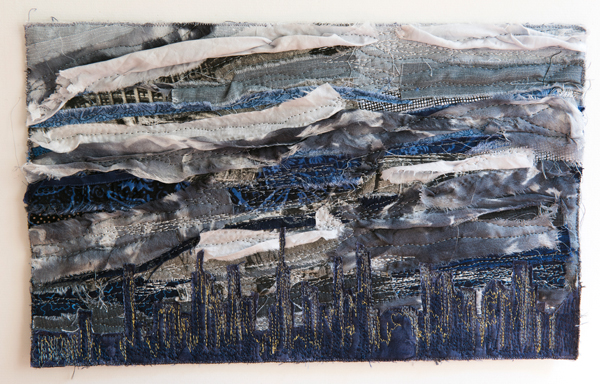
“It is great to be in non-juried exhibitions, too, but you are never sure that your work is good enough. It is very exciting to be accepted into a juried exhibition — it ratifies what you are doing and gives you more confidence,” she says. “Having your work rejected can be daunting but I have come to realise that it is not always the quality of the work that was the problem. Sometimes it is that you haven’t addressed the criteria properly or that your work just doesn’t fit the ideas of the curators. Sometimes it is that you haven’t sent a great image. I am learning to keep on trying, not to be put off if my work is not accepted.”
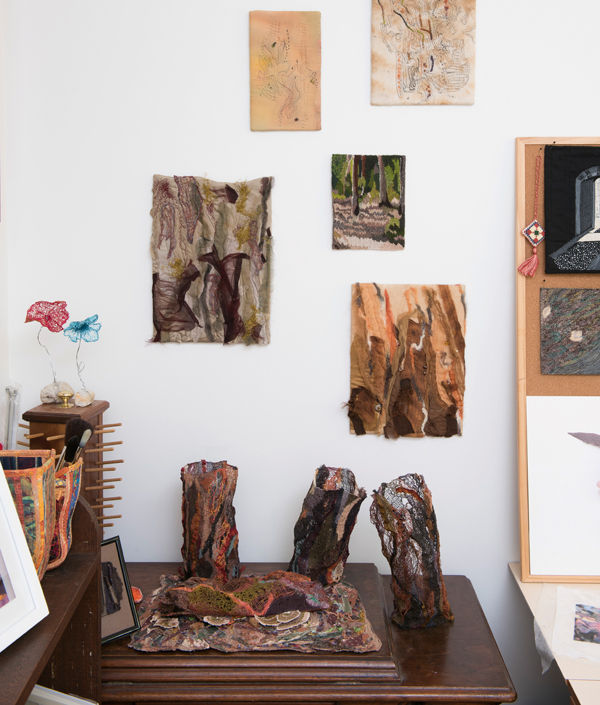
Mary is grateful that her renovated studio facilitates all her creative endeavours. “It is great to open the door of the cupboard and see the stuff there, all organised into colours and materials, easy to access. The clutter and stepping over boxes is gone. I love my studio now. I usually put my iPod on ‘shuffle songs’ and let it drown out any household noise. It is my space and I love it.”
For more information about Mary’s work, visit her blog: mary-marymac.blogspot.com.au

